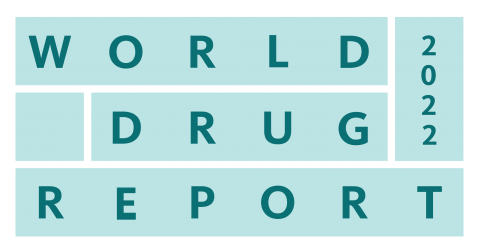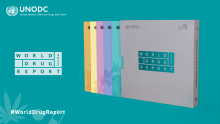The UN Office on Drugs and Crime (UNODC) World Drug Report 2022 has found that cannabis legalisation in parts of the world appears to have accelerated its use and increased the health impacts associated with cannabis consumption, particularly amongst young adults.
Released on June 27th, the report also details record rises in the manufacturing of cocaine, the expansion of synthetic drugs to new markets, and continued gaps in the availability of drug treatments, especially for women.
According to the report, around 284 million people aged 15-64 used drugs worldwide in 2020, a 26 per cent increase over the previous decade. Young people are using more drugs, with use levels today in many countries higher than with the previous generation. In Africa and Latin America, people under 35 represent the majority of people being treated for drug use disorders.
Globally, the report estimates that 11.2 million people worldwide were injecting drugs. Around half of this number were living with hepatitis C, 1.4 million were living with HIV, and 1.2 million were living with both. Reacting to these findings, UNODC Executive Director Ghada Waly stated: “Numbers for the manufacturing and seizures of many illicit drugs are hitting record highs, even as global emergencies are deepening vulnerabilities.
At the same time, misperceptions regarding the magnitude of the problem and the associated harms are depriving people of care and treatment and driving young people towards harmful behaviours. We need to devote the necessary resources and attention to addressing every aspect of the world drug problem, including the provision of evidence-based care to all who need it, and we need to improve the knowledge base on how illicit drugs relate to other urgent challenges, such as conflicts and environmental degradation.”
The report further emphasises the importance of galvanising the international community, governments, civil society and all stakeholders to take urgent action to protect people, including by strengthening drug use prevention and treatment and by tackling illicit drug supply.
Cannabis legalisation and global use trends
The report says that cannabis legalisation in North America appears to have increased daily cannabis use, especially potent cannabis products and particularly among young adults. Associated increases in people with psychiatric disorders, suicides and hospitalisations have also been reported.
Prevalence of use of cannabis varies widely by region and is highest in North America, Australia and New Zealand, and West Africa. In many countries in Africa and South and Central America, the largest proportion of people in treatment for drug use disorders are there primarily for cannabis use disorders.
Global trends: production, trafficking and consumption
Cocaine manufacture was at a record high in 2020, growing 11 per cent from 2019 to 1,982 tons. Cocaine seizures also increased, despite the Covid-19 pandemic, to a record 1,424 tons in 2020. Nearly 90 per cent of cocaine seized globally in 2021 was trafficked in containers and/or by sea. Seizure data suggest that cocaine trafficking is expanding to other regions outside the main markets of North America and Europe, with increased levels of trafficking to Africa and Asia.
Trafficking of methamphetamine continues to expand geographically, with 117 countries reporting seizures of methamphetamine in 2016‒2020 versus 84 in 2006‒2010. Meanwhile, the quantities of methamphetamine seized grew five-fold between 2010 and 2020.
Opium production worldwide grew seven per cent between 2020 and 2021 to 7,930 tons – predominantly due to an increase in production in Afghanistan. However, the global area under opium poppy cultivation fell by 16 per cent to 246,800 hectares in the same period. In Eastern and South-Eastern Europe and in Central Asia, people are most often in treatment for opioid use disorders. In the United States and Canada, overdose deaths, predominantly driven by an epidemic of the non-medical use of fentanyl, continue to break records. Preliminary estimates in the United States point to more than 107,000 drug overdose deaths in 2021, up from nearly 92,000 in 2020. Great inequality remains in the availability of pharmaceutical opioids for medical consumption. In 2020, there were 7,500 more doses per 1 million inhabitants of controlled pain medication in North America than in West and Central Africa.
Methamphetamine seizures rose by seven per cent in North America from the previous year, while in South-East Asia they increased by 30 per cent from the previous year, record highs in both regions. A record high was also reported for methamphetamine seizures reported from South-West Asia, increasing by 50 per cent in 2020 from 2019.
Conflict zones facilitating synthetic drug production
This year’s report also highlights that illicit drug economies can flourish in situations of conflict and where the rule of law is weak, and in turn can prolong or fuel conflict. Information from the Middle East and South-East Asia suggests that conflict situations can facilitate the manufacture of synthetic drugs. This effect may be greater when the conflict area is in close proximity to significant consumer markets that allow parties to use drugs to finance conflict and generate income.
Environmental impacts
Illicit drug markets, according to the report, can have local, community, or individual-level impacts on the environment. Key findings include that the carbon footprint of indoor cannabis cultivation is between 16 to 100 times more than outdoor cannabis cultivation on average and that the footprint of one kilogram of cocaine is 30 times greater than that of cocoa beans.
Other environmental impacts include substantial deforestation associated with illicit coca cultivation, waste generated during synthetic drug manufacture that can be 5 to 30 times the volume of the end product, and the dumping of waste which can affect soil, water and air directly, as well as organisms, animals and the food chain indirectly.
Ongoing gender treatment gap and disparities
Globally, women are in the minority when it comes to drug usage, yet they tend to increase their rate of drug consumption and progress to drug use disorders at a much faster rate than men do. Women now represent an estimated 45 to 49% of end users of amphetamines and non-medical users of pharmaceutical stimulants, pharmaceutical opioids, sedatives, and tranquillizers.
The treatment gap remains large for women globally. Although women represent almost one in two amphetamines users, they constitute only one in five people in treatment for amphetamine use disorders. The World Drug Report 2022 also spotlights the wide range of roles fulfilled by women in the global cocaine economy, including cultivating coca, transporting small quantities of drugs, selling to consumers, and smuggling into prisons.
** *** **
The 2022 World Drug Report provides a global overview of the supply and demand of opiates, cocaine, cannabis, amphetamine-type stimulants and new psychoactive substances (NPS), as well as their impact on health.
For further information, please visit: World Drug Report 2022 homepage

